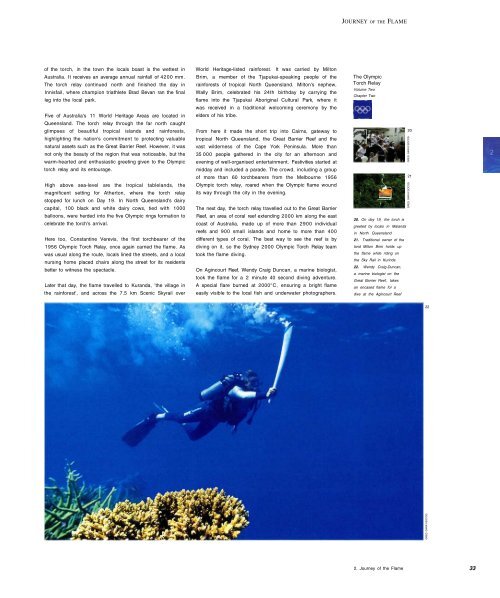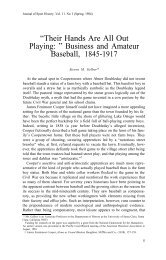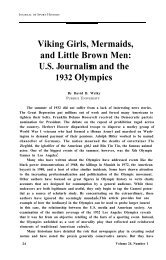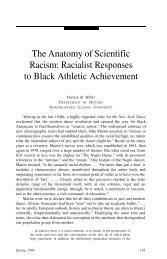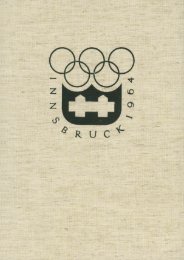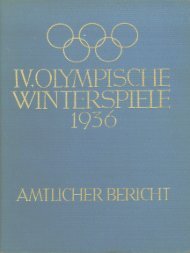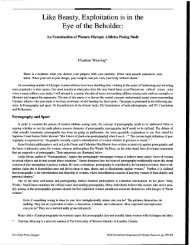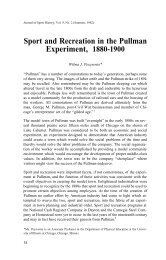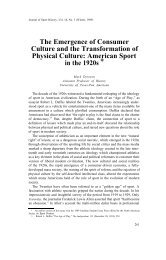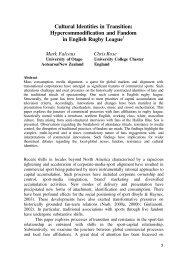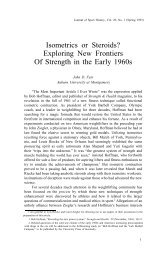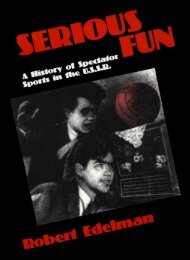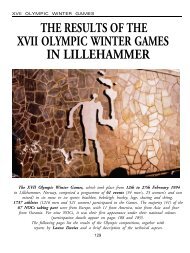II - A Legacy of the 1984 Olympic Games
II - A Legacy of the 1984 Olympic Games
II - A Legacy of the 1984 Olympic Games
You also want an ePaper? Increase the reach of your titles
YUMPU automatically turns print PDFs into web optimized ePapers that Google loves.
<strong>of</strong> <strong>the</strong> torch, in <strong>the</strong> town <strong>the</strong> locals boast is <strong>the</strong> wettest in<br />
Australia. It receives an average annual rainfall <strong>of</strong> 4200 mm.<br />
The torch relay continued north and finished <strong>the</strong> day in<br />
Innisfail, where champion triathlete Brad Bevan ran <strong>the</strong> final<br />
leg into <strong>the</strong> local park.<br />
Five <strong>of</strong> Australia's 11 World Heritage Areas are located in<br />
Queensland. The torch relay through <strong>the</strong> far north caught<br />
glimpses <strong>of</strong> beautiful tropical islands and rainforests,<br />
highlighting <strong>the</strong> nation's commitment to protecting valuable<br />
natural assets such as <strong>the</strong> Great Barrier Reef. However, it was<br />
not only <strong>the</strong> beauty <strong>of</strong> <strong>the</strong> region that was noticeable, but <strong>the</strong><br />
warm-hearted and enthusiastic greeting given to <strong>the</strong> <strong>Olympic</strong><br />
torch relay and its entourage.<br />
High above sea-level are <strong>the</strong> tropical tablelands, <strong>the</strong><br />
magnificent setting for A<strong>the</strong>rton, where <strong>the</strong> torch relay<br />
stopped for lunch on Day 19. In North Queensland's dairy<br />
capital, 100 black and white dairy cows, tied with 1000<br />
balloons, were herded into <strong>the</strong> five <strong>Olympic</strong> rings formation to<br />
celebrate <strong>the</strong> torch's arrival.<br />
Here too, Constantine Verevis, <strong>the</strong> first torchbearer <strong>of</strong> <strong>the</strong><br />
1956 <strong>Olympic</strong> Torch Relay, once again carried <strong>the</strong> flame. As<br />
was usual along <strong>the</strong> route, locals lined <strong>the</strong> streets, and a local<br />
nursing home placed chairs along <strong>the</strong> street for its residents<br />
better to witness <strong>the</strong> spectacle.<br />
Later that day, <strong>the</strong> flame travelled to Kuranda, '<strong>the</strong> village in<br />
<strong>the</strong> rainforest', and across <strong>the</strong> 7.5 km Scenic Skyrail over<br />
World Heritage-listed rainforest. It was carried by Milton<br />
Brim, a member <strong>of</strong> <strong>the</strong> Tjapukai-speaking people <strong>of</strong> <strong>the</strong><br />
rainforests <strong>of</strong> tropical North Queensland. Milton's nephew,<br />
Wally Brim, celebrated his 24th birthday by carrying <strong>the</strong><br />
flame into <strong>the</strong> Tjapukai Aboriginal Cultural Park, where it<br />
was received in a traditional welcoming ceremony by <strong>the</strong><br />
elders <strong>of</strong> his tribe.<br />
From here it made <strong>the</strong> short trip into Cairns, gateway to<br />
tropical North Queensland, <strong>the</strong> Great Barrier Reef and <strong>the</strong><br />
vast wilderness <strong>of</strong> <strong>the</strong> Cape York Peninsula. More than<br />
35 000 people ga<strong>the</strong>red in <strong>the</strong> city for an afternoon and<br />
evening <strong>of</strong> well-organised entertainment. Festivities started at<br />
midday and included a parade. The crowd, including a group<br />
<strong>of</strong> more than 60 torchbearers from <strong>the</strong> Melbourne 1956<br />
<strong>Olympic</strong> torch relay, roared when <strong>the</strong> <strong>Olympic</strong> flame wound<br />
its way through <strong>the</strong> city in <strong>the</strong> evening.<br />
The next day, <strong>the</strong> torch relay travelled out to <strong>the</strong> Great Barrier<br />
Reef, an area <strong>of</strong> coral reef extending 2000 km along <strong>the</strong> east<br />
coast <strong>of</strong> Australia, made up <strong>of</strong> more than 2900 individual<br />
reefs and 900 small islands and home to more than 400<br />
different types <strong>of</strong> coral. The best way to see <strong>the</strong> reef is by<br />
diving on it, so <strong>the</strong> Sydney 2000 <strong>Olympic</strong> Torch Relay team<br />
took <strong>the</strong> flame diving.<br />
On Agincourt Reef, Wendy Craig Duncan, a marine biologist,<br />
took <strong>the</strong> flame for a 2 minute 40 second diving adventure.<br />
A special flare burned at 2000°C, ensuring a bright flame<br />
easily visible to <strong>the</strong> local fish and underwater photographers.<br />
JOURNEY OF THE FLAME<br />
The <strong>Olympic</strong><br />
Torch Relay<br />
Volume Two<br />
Chapter Two<br />
20. On day 19, <strong>the</strong> torch is<br />
greeted by locals in Malanda<br />
in North Queensland<br />
21. Traditional owner <strong>of</strong> <strong>the</strong><br />
land Milton Brim holds up<br />
<strong>the</strong> flame while riding on<br />
<strong>the</strong> Sky Rail in Kurinda<br />
22. Wendy Craig-Duncan,<br />
a marine biologist on <strong>the</strong><br />
Great Barrier Reef, takes<br />
an encased flame for a<br />
dive at <strong>the</strong> Agincourt Reef<br />
20<br />
GREG GARAY/SOCOG<br />
21<br />
GREG GARAY/SOCOG<br />
2. Journey <strong>of</strong> <strong>the</strong> Flame 33<br />
22<br />
GREG GARAY/SOCOG


